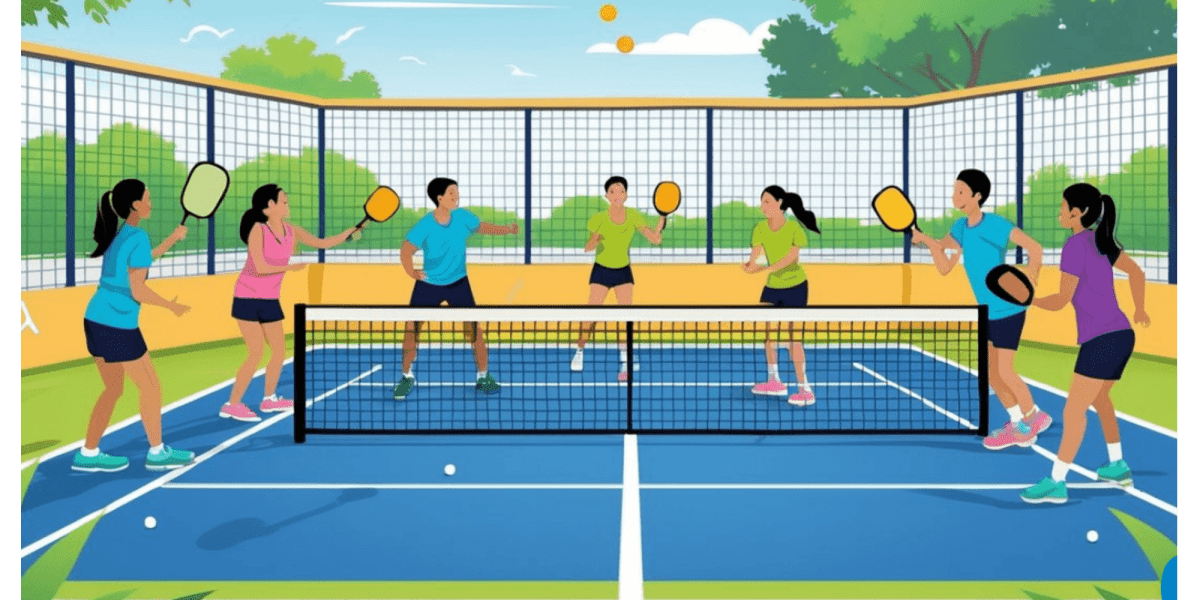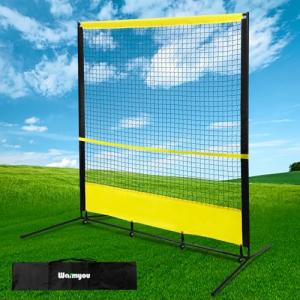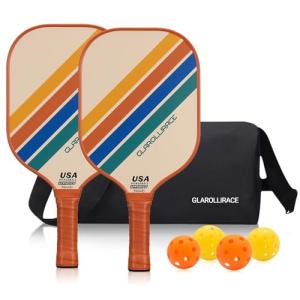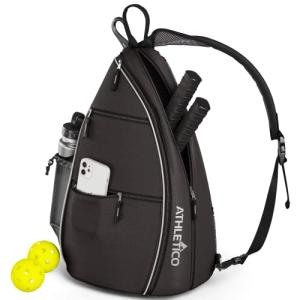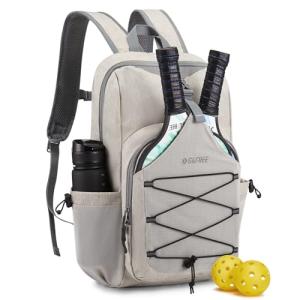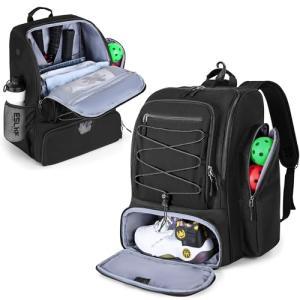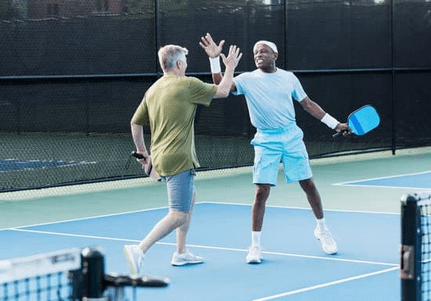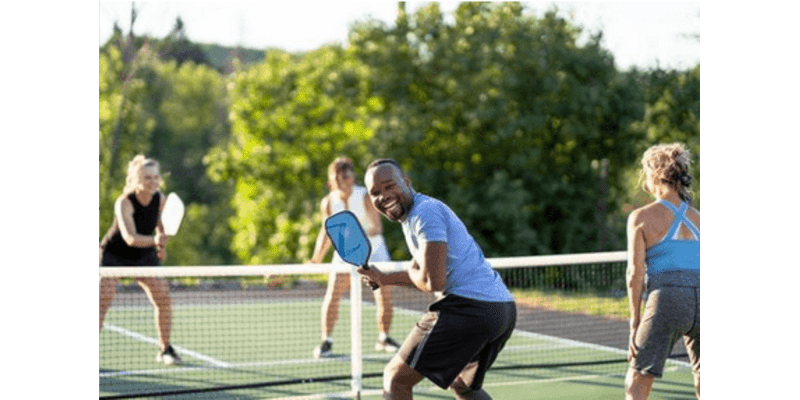Master the Basics and Start Playing Today
Pickleball has taken off as America's fastest-growing sport. It blends tennis, badminton, and ping pong into a game that's both fun and easy to pick up for almost anyone.
This paddle sport utilizes a smaller court than tennis, which is a relief for your joints, yet still provides a solid workout. You hit a perforated plastic ball over a net using solid paddles, and the rules are simple enough that you can pick them up in just one session.

You don't need much to get started—just a paddle, a ball, and a court with the right markings. These days, you can find dedicated pickleball courts or modified tennis courts at lots of parks and community centers.
Singles and doubles are both options, though doubles is usually the go-to for beginners. It's less running and more social, which never hurts.
Key Takeaways
- Pickleball combines elements of tennis, badminton, and ping-pong, utilizing solid paddles and a plastic ball on a smaller court.
- Basic equipment is just a paddle and a ball, and most parks or rec centers have courts ready to go.
- The rules and scoring are straightforward, so you can start playing and having fun almost right away.
Understanding the Basics of Pickleball
Pickleball is a fast-growing paddle sport that borrows from games you probably already know. If you get the basics down, you'll have a good time right from the start.
What Is Pickleball
Pickleball is played with solid paddles and a plastic ball full of holes, on a 20-by-44-foot court. The net stands 36 inches high at the sides, dipping to 34 inches in the middle.
You can play singles (one per side) or doubles (two per side), though doubles is more common. Unlike tennis, serves are always underhand.
There's a 7-foot "non-volley zone" on each side of the net, known as "the kitchen." You can't hit the ball in the air while standing in this area.
Brief History and Origin
Back in 1965, Joel Pritchard, Bill Bell, and Barney McCallum invented pickleball on Bainbridge Island, Washington. Their families wanted to play badminton, but they couldn't find the necessary gear.
So, they grabbed ping-pong paddles and a plastic ball, then lowered the net. That little experiment turned into a whole new game.
The name "pickleball" has two possible stories. Some folks say it was named after the Pritchards' dog, Pickles. Others say Joan Pritchard thought the mix of sports was like a "pickle boat" in crew, where leftovers from other boats are combined to form a team.
Comparing Pickleball to Tennis, Badminton, and Table Tennis
Pickleball borrows from several racquet sports, but it's its own thing. The court is smaller than a tennis court—about one-third the size—but larger than a badminton court.
Serves are always underhanded and diagonal, unlike tennis. The scoring is similar to badminton, with only the serving team able to score points.
Key Differences:
- Tennis: Bigger court, overhead serves, and a different ball
- Badminton: Court layout is similar, but the net and gear are different
- Table Tennis: Paddle grip and some strategy overlap, but it's played on a table
Pickleball is generally easier on the body than tennis, making it suitable for all ages. The smaller court means less running, and the ball moves slower than a tennis ball.
Pickleball Equipment and Court Layout

Before you even hit the court, it's good to know what gear you'll need and how the court is set up. The right equipment and a sense of the court's layout make the game way more enjoyable—and safer, too.
Pickleball Paddles and Balls
Pickleball paddles are available in wood, composite, or graphite materials. Most beginners opt for composite paddles because they offer a nice balance of power, control, and price.
Paddles usually weigh between 7 and 9 ounces. Lighter ones give you more control, while heavier paddles pack more punch. Go with what feels right for your swing and strength.
The balls are plastic with holes, similar to Wiffle balls. You've got two types:
- Indoor balls: Lighter, smaller holes
- Outdoor balls: A bit heavier, bigger holes to handle the wind
Ensure you use the correct ball for your court. It makes a difference in how the game plays out.
Pickleball Court Dimensions and Features
A standard pickleball court measures 20 feet in width and 44 feet in length. That's about a third of a tennis court, so it's pretty approachable for most folks.
The court has a few main sections:
- Right service area
- Left service area
- Non-volley zone (7 feet from the net on both sides)
- Baseline (the back boundary line)
Lines are typically painted in a color that contrasts with the surface. For temporary courts, you can use tape or portable lines.
Many tennis courts are converted for pickleball with temporary lines. You can fit up to four pickleball courts on one tennis court, which is pretty efficient if you ask me.
Understanding the Net and Non-Volley Zone
The pickleball net is 36 inches high at the sidelines and dips to 34 inches in the middle. That little dip actually makes serves trickier and keeps things fair.
Portable nets are out there for casual games, and you can set them up on almost any flat surface in just a few minutes.
The standout feature is the non-volley zone, or "the kitchen," which is 7 feet deep on both sides of the net. A few key rules here:
- You can't volley (hit the ball in the air) while standing in or touching the kitchen
- It's fine to step into the kitchen to hit a ball after it bounces
- Once you hit a ball in the kitchen, you have to get out before your next shot
The kitchen keeps people from smashing the ball right at the net, so rallies get more interesting and strategic.
Pickleball Rebound Net and Practice Trainer
Enhance your skills and sharpen your game with this easy-to-use pickleball rebound net
Product information
$78.99 $65.56
Product Review Score
4.96 out of 5 stars
34 reviewsProduct links
Fundamental Rules of Pickleball

Pickleball has its own set of rules that make it easy for newbies, but still a good challenge if you've played for a while. Knowing these basics gets you up to speed quickly.
Basic Rules and Regulations
Pickleball courts are the same size as a badminton court—20 by 44 feet. Most games go to 11 points, and you need to win by 2.
Only the serving team can score. When the serving team makes a mistake (a "fault"), they lose the serve, and the other team gets their turn.
In doubles, both teammates serve before the serve switches to the opponents, except at the very start of the game when only one partner serves.
Serves must be underhand and diagonal, landing in the opposite service court. Keep your feet behind the baseline and hit the ball below your waist.
Kitchen Rules and Non-Volley Zone
The "kitchen" or non-volley zone stretches 7 feet from the net on both sides. It's a signature rule in pickleball.
Key kitchen rules:
- No volleying in the kitchen or while touching its line
- Don't step into the kitchen after a volley because of momentum
- It's fine to stand in the kitchen to hit a ball that's bounced
The kitchen rule prevents players from camping at the net and smashing the ball, allowing for more thoughtful and strategic rallies. If you or your clothes touch the kitchen during or after a volley, that's a fault and you lose the point.
Pickleball Faults and Violations
Faults mean you lose your serve or a point. Common ones include:
- Hitting the ball out of bounds
- Not clearing the net
- Volleying from inside the kitchen
- Stepping on the baseline while serving
- Sending the ball into the net
Other violations are:
- Touching the net with your paddle or body
- Hitting the ball before it crosses the net to your side
- Double-hitting the ball on one stroke
- Carrying or catching the ball instead of a clean hit
If you're serving and fault, you lose your serve. If you're receiving and the server faults, you get the serve.
Double Bounce Rule
The double-bounce rule states that the ball must bounce once on each side after the serve before anyone can volley.
Therefore, the receiving team lets the serve bounce before returning it. Then, the serving team lets that return bounce before hitting it back.
After those two bounces, you can volley or let it bounce. This rule slows things down at first, which is beneficial for beginners, and it encourages both teams to position themselves near the non-volley line for more strategic play.
Serving and Returning the Ball
The serve and return really set the vibe for every point in pickleball. If you get these basic skills down, you'll have an easier time taking control at the kitchen line.
How to Serve in Pickleball
The serve in pickleball must be underhand and directed diagonally across the court. Keep both feet behind the baseline and make sure you hit the ball below your waist.
Try aiming for the deep corners of your opponent's service box. That way, it's tougher for them to attack and gives you a little extra time to move up toward the non-volley zone (the kitchen line).
Serve from the right side when your score is even, left when it's odd. Unlike tennis, you get just one serve attempt per turn.
Common serving faults to avoid:
- Stepping on or over the baseline before contact
- Hitting the ball above waist level
- Serving to the wrong service court
- Hitting the net, even if the ball lands in the right area
Underhand Serve Technique
For a proper underhand serve, set your feet shoulder-width apart behind the baseline. Hold the ball in your non-dominant hand and the paddle in your dominant hand.
Basic serving steps:
- Drop the ball from waist height
- Swing the paddle forward in a pendulum motion
- Hit the ball with an upward motion
- Follow through on your target
Try to contact the ball in the center of your paddle for better control. Mix up your speeds and spins to keep opponents guessing. Honestly, a good serve doesn't have to be fast—accuracy matters more.
Rules for Returning the Serve
Return the serve after the ball bounces once in your service court. That's the "double bounce rule" you hear about in pickleball.
Aim your return deep into your opponent's court. This keeps them from attacking right away and gives you time to move up to the kitchen line.
Tips for effective returns:
- Wait for the bounce before hitting
- Step into your return for more power
- Target your opponent's feet or backhand
- Change up your pace and placement to keep them guessing
The receiving team has to let the ball bounce before hitting it back. If the wrong player returns the serve, the serving team gets the point. After both the serve and return have bounced, anyone can volley as long as they're not in the kitchen zone.
Playing the Game: Strokes, Positioning, and Communication
Mastering pickleball takes more than just knowing the rules. You'll need to develop solid strokes, smart court positioning, and real teamwork if you're playing doubles.
Forehand and Backhand Strokes
The forehand is your go-to shot, using the front of your paddle. Keep your paddle in front of you, above your chest, to react quickly. For forehand shots, rotate your shoulders a bit and step toward the ball with your opposite foot.
Backhand strokes need a different grip and stance. Turn sideways so your non-dominant shoulder faces the net. Keep your wrist steady and use your shoulder and arm for power, not just your wrist.
With both strokes, focus on control over power. Use a relaxed grip (maybe 3/10 tightness) for softer shots like dinks and drops to avoid popping the ball up.
Practicing these strokes against a wall is super helpful for building muscle memory and consistency.
Court Positioning and Footwork
Where you stand matters a lot in pickleball. After serving, move up to the non-volley zone (kitchen) line for better angles and control.
Key positioning principles:
- Stay in a ready position—knees bent, weight forward
- Get to the kitchen line as soon as you can
- In doubles, move side-to-side with your partner like you're connected
- Return to the center after each shot
Good footwork means staying light on your feet and taking quick, small steps. Don't cross your feet when moving sideways—shuffle instead to keep your balance.
If your opponent sends a deep shot, back up far enough to let the ball bounce and hit it comfortably. Then, hustle forward to reclaim your spot.
Effective Communication in Doubles Play
Talking with your partner keeps things smooth and avoids those awkward missed shots. Set up some basic cues before you play:
- Call "Mine" or "Got it" for balls in the middle
- Say "Bounce it" if your partner should let it drop
- Yell "Up" if a lob is going over their head
Use simple signals for serving or positioning. A hand behind the back can show where you plan to serve or which opponent to target.
It's smart to talk about your strengths and which side you prefer before the game. Right- and left-handed partners can cover more ground if they set up right.
And honestly, a little encouragement after a missed shot or a high-five after a great play goes a long way. Positive vibes make the game more fun.
Scoring System Explained
Pickleball scoring can look confusing at first, but it follows a pretty logical pattern. It just takes a little practice before it feels automatic. The system keeps track of points and rotates the serve between players.
Traditional Scoring
Only the serving team scores points in traditional pickleball. Games usually go to 11 points, and you have to win by at least 2. In tournaments, games might go to 15 or 21.
When you call the score in doubles, announce three numbers: the serving team's score, the receiving team's score, and the server number (1 or 2). For example, "5-3-2" means the serving team has 5, receivers have 3, and it's the second server's turn.
Singles is simpler—just call the server's score and the receiver's score.
The team that serves first in a game only gets one server for their first turn. People call this the "first server exception" rule.
Rally Scoring in Pickleball
Rally scoring allows either team to score a point, regardless of who serves. This makes games move faster since every rally counts.
Games with rally scoring usually go to 15 or 21 points, still needing a 2-point lead to win. It's not as common in official tournaments, but a lot of people use it for casual games because it keeps things moving.
Rally scoring eliminates side-outs, making the game simpler for beginners. Just keep track of the score and rotate serves as usual.
Many community centers and casual players utilize rally scoring, particularly when courts are busy and they want to maximize playtime.
Understanding Side Outs
A side out occurs when the serving team loses a rally, allowing the opposing team to serve. In traditional scoring, you don't get a point for a side out—the serve switches.
After a side out in doubles, both players on the new serving team get to serve before the point returns to the other team. The player in the right-hand court (even score) always serves first after a side out.
Side outs are big moments in pickleball strategy. Teams often use them to reset and refocus.
During competitive play, knowing when a side out is coming helps you prepare for the next serve and adjust your tactics. The team getting the serve after a side out should be ready to take advantage.
Singles and Doubles: Game Formats
Pickleball gives you two main ways to play: singles (one player per side) or doubles (two per team). Each style presents distinct physical demands, strategies, and social dynamics.
Singles Play Overview
In singles, you're covering the whole court by yourself. The court size stays the same as doubles (20 × 44 feet), but it's all on you to defend that space.
This format is tough and requires good conditioning and fast movement. Singles matches usually have more groundstrokes and longer rallies than doubles.
Serve from the right side when your score is even, left when it's odd. Control and smart placement matter more than power in singles—try to push your opponent into tricky spots.
Singles draws in younger players and those with tennis backgrounds who enjoy the extra movement and challenge.
Doubles Pickleball Basics
Doubles is by far the most popular way to play. It's social and lets you share the court with a friend or partner.
Start each point side by side with your partner. After serving, both players try to move up to the non-volley zone (kitchen line) for better positioning.
The serving order is different from singles. The first server continues serving until it fails, then its partner takes over. After the second server fault, the server switches to the other team.
Talking with your partner is super important in doubles. Calls like "mine," "yours," or "bounce it" help avoid confusion when things get fast.
Unique Strategies for Each Format
Singles Strategies:
- Hit deep serves to push your opponent back
- Mix in lobs and drop shots to move them around
- Focus on stamina and covering the court
- Hit to open spaces since one player has to cover it all
Doubles Strategies:
- Work on your "third shot drop" to neutralize opponents at the kitchen line
- Both players should get to the kitchen line when possible
- Coordinate with your partner to cover the middle
- Try "stacking" to optimize court coverage for your team
"Skinny singles" is a fun hybrid where you use just half the court width, so it feels a bit like doubles but it's still one-on-one.
Doubles is all about volleys and quick hands at the kitchen, while singles is more baseline play and running.
Beginner Strategies and Tips for Success
Improving at pickleball comes down to a few basic strategies and avoiding common mistakes. These tips will help you go from total beginner to a more confident player.
Building Consistency and Patience
Consistency is everything in pickleball. Focus on just getting the ball over the net and in the court, not blasting winners every time.
Work on a reliable serve that lands deep in the court. That puts instant pressure on your opponent and gives you a head start.
Patience matters during rallies. Many beginners attempt to end points with hard shots, but this usually leads to mistakes. Keep the ball in play and let your opponent make the first mistake.
The "third shot drop" is a huge part of pickleball. After your serve and your opponent's return, try to hit a soft shot into the kitchen (non-volley zone). That lets you move up and control the point from the net.
Practicing Dinks and Soft Shots
Dinks are soft shots that land in the kitchen area. They're essential for controlling the pace and creating opportunities to win points.
Grab a partner and practice dinking, aiming to keep the ball low over the net. The best dink arcs a bit and drops just past the kitchen line, making it tough for your opponent to attack.
Try not to flick your wrist much when dinking. Use your legs and core for power and keep your paddle face slightly open, meeting the ball out in front.
Soft shots aren't just for the kitchen. Work on hitting gentle "drops" from the baseline that land softly in your opponent's kitchen—it boosts your control.
Common Mistakes to Avoid
Staying too far back limits your options. Move up to the kitchen line when you can for better control over the point.
Don’t smash the ball unless you need to. Beginners often swing too hard and end up making mistakes—placement matters more than power.
Be careful not to stand in the kitchen during volleys. That’s a common rule slip-up for new players.
Keep an eye on your feet. Beginners sometimes stand flat-footed or forget to reset between shots—stay light, knees bent, paddle up and ready.
Don’t ignore your non-dominant side. Practice backhands or turning to hit forehands on your weaker side to cover this gap in your game.
Pickleball Community and Sportsmanship
Pickleball thrives on its strong community and friendly sportsmanship. Players at every level help keep the atmosphere welcoming, and honestly, that’s a significant reason why the sport continues to grow all over the country.
USA Pickleball and Organizations
USA Pickleball is the national governing body for the sport in the United States. They establish official rules and standards and work to promote pickleball nationwide.
This group sanctions tournaments at all levels, from local to national, providing players with numerous opportunities to compete and test their skills.
Most communities now have local pickleball clubs offering regular games, clinics, and social events. Rec centers, YMCAs, and park departments are also adding pickleball to their programs.
Online, players connect through websites, forums, and social media. It’s easy to find tips, meet other enthusiasts, or set up games even if you’re new in town.
Emphasizing Sportsmanship
The USA Pickleball Sportsmanship Guide puts respect, fair play, and graciousness front and center. Good sportsmanship means calling your own faults honestly and respecting your opponent’s line calls.
Players should congratulate opponents on good shots and avoid negative reactions like paddle slamming or shouting. This culture keeps the game fun for everyone.
Key sportsmanship practices:
- Introducing yourself to new players
- Making fair line calls
- Acknowledging good plays by opponents
- Maintaining a positive attitude regardless of score
- Being gracious in both winning and losing
Growing the Pickleball Community
The community continues to expand, often through friends introducing friends. Many people become hooked after someone invites them to try a game or two.
Beginner clinics and lessons also help new players learn the basics in a low-pressure setting. It’s a great way to get started without feeling lost.
Pickleball stands out for being inclusive. Players of all ages, abilities, and backgrounds can jump in and have fun.
Mixed-level play is typical, and experienced players often help out beginners. It’s a cool way to learn fast and build friendships at the same time.
Public courts and dedicated facilities are popping up everywhere. Many towns have converted old tennis courts or built new complexes just for pickleball—it’s wild how quickly they fill up.
Frequently Asked Questions
New pickleball players often have questions about gear, scoring, and how to play effectively. Here are some basics to help you get started.
What are the basic equipment requirements for playing pickleball?
You’ll need a paddle, pickleballs, and the right court shoes. Paddles come in wood, composite, or graphite and can cost anywhere from $15 to $150.
Pickleballs are plastic with holes, similar to Wiffle balls but sturdier. Indoor and outdoor balls look a bit different to match the conditions.
Good court shoes with non-marking soles are a must for quick moves and safe stops on the court.
How do you keep score in a pickleball game?
Only the serving team can score points in pickleball. Games usually go to 11, and you have to win by two.
Before each serve, call out three numbers: your team’s score, the other team’s score, and the server number (1 or 2 in doubles).
In singles, it’s just two numbers—the server’s score and the receiver’s.
What are the fundamental rules for serving in pickleball?
Serve underhand with your paddle below the waist. Keep both feet behind the baseline and serve diagonally across the court.
The serve must land in the diagonal service box, past the non-volley zone. If the ball hits the net but lands in the right spot, it’s a “let” and you serve again.
Each team gets one serve per side in doubles before it switches, unless you score a point and keep serving.
Can you explain the proper technique for serving in pickleball?
Start with a comfortable stance behind the baseline, feet shoulder-width apart. Hold the ball in your non-dominant hand.
Drop the ball and swing underhand, making contact below your waist. Try to hit it deep into the service court.
Focus on consistency more than power. A solid serve puts your opponent on the defensive right from the start.
How does doubles play differ from singles in pickleball?
Doubles uses the full court, while singles is a bit narrower. In doubles, you and your partner switch sides after your team scores a point.
Talking to your partner is crucial. Call out “mine” or “yours” so you don’t both go for the same shot or leave the ball hanging.
The main doubles strategy? Get to the non-volley zone line fast and cover the court together. It’s all about teamwork and smart positioning.
What strategies should beginners focus on to improve their pickleball game?
If you're starting out, try to focus on placing the ball where you want it instead of just hitting hard every time. It's usually smarter to keep the ball in play and avoid easy mistakes.
The "third shot drop"—yeah, that's a big one. Work on this gentle shot that lands in your opponent's kitchen area, since it'll make them hit up and buy you time to move closer to the net.
Be patient with your shots and pay attention to your positioning on the court. Getting up to the non-volley zone can help, but if you rush forward without control, you'll probably make errors.
Pickleball Match Score Tracker Tool
Keep your games organized and fun with this easy-to-use score tracking tool!
Product information
$15.99 $12.58
Product Review Score
4.09 out of 5 stars
175 reviewsProduct links
Pickleball Paddles Set with Balls and Bag
Everything you need to hit the court and start your pickleball journey!
Product information
$39.99 $28.79
Product Review Score
4.41 out of 5 stars
101 reviews